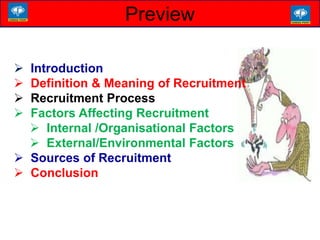Recruitment
- 1. Sanjiv Kumar Mahajan Career Points University Kota
- 3. Introduction HRP • Demand Forecasting • Number & Type Job Analysis & Job Design • Tasks • Responsibilities • Qualifications Hiring • Recruitment • Selection
- 4.  HRP helps HR Demand forecasting  The number  Type of people a firm needs.  Job analysis and job design specify the tasks and duties of jobs and the qualifications expected from prospective job holders.  The next logical step is to hire the right number of people of the right type to fill the jobs.  Hiring involves two broad groups of activities  Recruitment  Selection Introduction HRP • Demand Forecasting • Number & Type Job Analysis & Job Design • Tasks • Responsibilities • Qualifications Hiring • Recruitment & Selection
- 5. Objective To learn about Recruitment & its importance Outcome Students will have in-depth understanding of Process of Recruitment, factors affecting recruitment and sources of recruitment. Recruitment
- 6. Preview ÔÉò Introduction ÔÉò Definition & Meaning of Recruitment ÔÉò Recruitment Process ÔÉò Factors Affecting Recruitment ÔÉò Internal /Organisational Factors ÔÉò External/Environmental Factors ÔÉò Sources of Recruitment ÔÉò Conclusion
- 7.  Process to discover the sources of manpower to meet the requirements of the staffing schedule and to employ effective measures for attracting that manpower in adequate numbers to facilitate effective selection of an efficient working force”.  Process of searching for potential applicants/ prospective employees and stimulating & encouraging them to apply for jobs in an organisation”  The process begins when new recruits are sought and ends when their screening has been carried out.  The result is a pool of applicants from which new employees are selected.  Difference between Recruitment & Selection Recruitment : Definition
- 8. 8 Recruitment vs Selection Recruitment Selection Process of searching for potential applicants/ prospective employees and stimulating & encouraging them to apply for jobs in an organisation It is a process of picking up more competent and suitable employees
- 9. • Continous Process • Linking Activity. Brings together employer and prospective employees • Pervasive Function. Applicable to all organisations at all levels • Two-way Process. Between employee and employer • Identifies Human Resources. • Fulfilment of Manpower Needs. • Dependency. Dependent on Job Analysis, Job description & Job Specifications Recruitment : Features
- 11.  Determine the present and future manpower requirements in conjunction with its HRP and job-analysis activities.  Identify and prepare potential job applicants who will be appropriate candidates.  Increase the pool of job candidates at minimum cost.  Increases Success rate of selection Objectives of Recruitment
- 12.  Meet the organization’s legal and social obligations regarding the demographic composition of its workforce.  Increase organizational and individual effectiveness in the short term and long term. Objectives of Recruitment
- 14. 14 Internal Factors Internal Factors  Recruitment Policy  Organisation Size  Organisation Image  Type of personnel to be recruited  Past Practices  Growth & Expansion  Cost Also called endogenous factors are within the control of organisation
- 15. 3/20/2012 THIS PPT BELONGS TO BRO CODE © 15 Recruitment Policy
- 16. Recruitment Policy  Provides a framework for the implementation of the recruitment programme in form of procedure.  Internal Recruitment  External Recruitment  Temporary or Part time employees  Recruitment of handicaps, Minority groups, Women employees & relatives of employees etc
- 17. Recruitment Policy Features of Good Recruitment Policy  Conform to general personnel policies.  Focus to recruit the best potential people.  Treatment of every applicant with dignity and respect.  Unbiased policy.  Transparent, task oriented and merit based selection.  Should match the qualities of prospective employees with job requirement.
- 18. 18 External Factors External Factors  Competition for HR  Legal Factors  Socio- cultural Factors  Supply & Demand  Labour Market  Unemployment rate  Sons of Soil Factors which are beyond the control of the organization
- 19. External Factors Legal Factors  Reservation of jobs for SC, STs, Minorities, OBCs.  Child Labour Act  Employment Exchange Act, Mines Act , The Factories Act etc Socio- Cultural Factors Restrict/Prevent employment of certain category of personnel ie Employment of women in some manufacturing operations.
- 20. External Factors Labour Markets  Employment conditions in area where the organisation is located influence recruiting effort.  Informal attempts ie even notice board display will of requisition will attract lot of applicants Supply and Demand  Supply and demand of particular skill in labour.  Extra ordinary recruiting effort needed when demand of skill is high relative to the supply.  Demand for programmers and financial analysts
- 21. 21 External Factors External Factors  Competition for HR  Legal Factors  Socio- cultural Factors  Supply & Demand  Labour Market  Unemployment rate  Sons of Soil Factors which are beyond the control of the organization
- 23. 23 Recruitment Process Personnel Planning Job Analysis Recruitment Planning  Numbers  Type Strategy Development Where (Local/ National Mkt) How When Searching Source Activation Selling Message Media Job Vacancy Applicant Pool Screening Evaluation & Control
- 24. Recruitment Planning Offer Acceptance(10) offer: acceptance(2:1) Job Offered(20) Interview : offer (10:1) Interview (200) Contact:Interview(10:1) Initial Contacts (2000) Yield Ratio expresses relation of applicant input to output at various level Type of Contacts Type of people to be informed about job openings Based on qualifications expected based on Job description & Job Specifications
- 25. 25 Recruitment Process Personnel Planning Job Analysis Recruitment Planning  Numbers  Type Strategy Development Where (Local/ National Mkt) How When Searching Source Activation Selling Message Media Job Vacancy Applicant Pool Screening Evaluation & Control
- 26. Searching Source Activation  Search method activated by issue of employee requisition by line manager.  Actual recruitment commences once line manager verifies that actual vacancy exists. Selling  Concerns Communication with potential employees through media.  Resist overselling their virtues.  Selection of Message( advertisement) & Media deserve attention.
- 27. 27 Recruitment Process Personnel Planning Job Analysis Recruitment Planning  Numbers  Type Strategy Development Where (Local/ National Mkt) How When Searching Source Activation Selling Message Media Job Vacancy Applicant Pool Screening Evaluation & Control
- 29. Sources of Recruitment  Recruitment sources are the medium of choosing candidates for recruitment process.  Sources considered after finalising the recruitment plan(no & type of potential candidates). Recruitment Internal Sources External Sources
- 30. Internal Sources Previous Applicants Referrals Transfers & Promotions Ex-Employees Internal Sources  Recruitment from within the organization.  Internal sources of recruitment are readily available to an organization.
- 31. 31 Transfers Transfers implies shifting of an employee from one job to another without any shift in change of responsibilities. Promotions Promotion refers to shifting of an employee to a higher position carrying higher status, responsibilities and pay. Former Employees  Ex-employees can be invited and appointed to fill vacancies in the organization.  There are situations when ex-employees provide unsolicited applications also.  Dependents and relatives of deceased and disabled employees Internal Sources
- 32. 32 Employee Referrals  Recommendations from a current employee regarding a job applicant who can be a friend or a family member  Good prospect for the friends & relatives of employees by aquainting them with advantages of job with the company and encouraging them to apply.  Microsoft, Wipro & Infosys offer referral incentives to its employees  Cost effective method. Internal Sources
- 33. 33 Internal Sources : Merits  Morale and motivation of employees improves.  Promotes loyalty and commitment amongst employees due to sense of job security and advancements.  Chances of proper selection high.  Present employees familiar with organization surroundings.  Time and expenditure for recruitment reduced
- 34. 34 Internal Sources : Demerits  Fails to bring in fresh blood into organization.  Promotion based on seniority.  Choice in selection is restricted.  All vacancies cannot be filled from within organization.  Not available to newly established enterprise.
- 35. External Sources Indirect Methods Third Party MethodsDirect Methods External Sources  Recruitment solicited from sources outside the organization.  External sources are external to a concern
- 36. Direct Method  Campus Recruitment  Recruitment at Factory Gate  Displaced Persons Indirect Method  Advertisement - Newspaper (want/blind advertisement), TV, Radio, Technical magazines & Brochures  Professional & Trade Associations provide placement to members  Competitors Third Party Methods  Private Employment Agencies  Employment Exchanges  Consultants. ABC Conultants, Ferguson Associates, Head Hunters etc External Sources
- 37.  Large Pool of Talent  Induction of Fresh Blood  Healthy Competition among existing employees & fresh inductees  Innovativeness Merits -External Sources
- 38.  Expensive  Time Consuming  De-motivation for existing employees Demerits of External Sources
- 39. 39 Recruitment vs Selection Basis Recruitment Selection Meaning Process of searching for potential applicants/ prospective employees and stimulating & encouraging them to apply for jobs in an organisation It is a process of picking up more competent and suitable employees Objective It encourages large number of Candidates for a job. It attempts at rejecting unsuitable candidates. Hurdles The candidates have not to cross over many hurdles. Many hurdles have to be crossed.
- 40. 40 Recruitment vs Selection Basis Recruitment Selection Approach It is a positive approach. It is a negative approach. Sequence It proceeds selection. It follows recruitment. Economy It is an economical method. It is an expensive method. Time Consuming Less time is required. More time is required.
- 42. Conclusion
- 43. Thank You










































